We warmly welcome Carole Nervig, author of The Petroglyphs of Mu: Pohnpei, Nan Madol and the Legacy of Mu, as our featured author for December. Carole’s book is a detailed exploration documenting her discoveries and investigation into the petroglyphs of Pohnpaid — an ancient megalithic site on the island of Pohnpei. Combining archaeological evidence with traditional oral accounts, Carole reveals how the legacy of Pohnpaid not only represents a geodetic network of ancient sacred sites but, she believes it is also a remnant of the now submerged but once enlightened Motherland of Mu. In her article here, Carole outlines some of her findings, such as the archaeoastronomical function of the Pohnpaid stones and how the archetypal symbols contained in Pohnpaid’s petroglyphs have exact counterparts in other ancient cultures throughout the world.
Interact with Carole on our AoM Forum here.
I join the ranks of countless researchers and authors who, for decades, have been influenced by Graham Hancock’s groundbreaking books on our ancient past.
Heaven’s Mirror was a pivotal catalyst on the path of writing my recently released The Petroglyphs of Mu: Pohnpei, Nan Madol and the Legacy of Mu. Hancock’s delineation of Pohnpei Island at 54° longitude (based on Giza as 0) as a navel/node/marker on the planetary grid system based upon the precession of the equinoxes, confirmed my own sense of the purpose of not only Nan Madol, the largest archaeological complex in the Pacific, but of the astounding yet previously unknown petroglyphs I discovered at Pohnpaid in 1992. In addition to my research based on oral histories, archaeological data, and personal experiences, Hancock provided another rationale for why cultural traditions and current peoples of Pohnpei Island insist that their island is indeed hallowed land. Then and now, Pohnpeians never doubted that their entire island was and is sacred — and not just because it is home to Nan Madol. That Pohnpei’s name translates literally to “upon a stone altar” provides insight into the primordial depth of its sacredness, present and identified millennia before Nan Madol.
When Hancock published his precession theories in conjunction with the ancient global longitudinal grid, I could no longer procrastinate in sharing my findings. I finally had enough validation to write my books about the sites upon this stone altar of Pohnpei.
Hancock’s Heaven’s Mirror provided a missing incentive to propel me along my life’s mission; Barbara Hand Clow’s belief in my book was the key to its manifestation. I am profusely indebted to both.
The Megalithic Library of Pohnpaid
What better media than stone would assure the ancients’ success in passing down their enlightened knowledge from era to era, generation to generation? Virtually indestructible, megaliths worldwide share this function, whether in the form of glyphs carved upon them or in their structural configurations, where their stories and technologies are embedded for us to unravel.
Conventional approaches have often been unsuccessful in revealing the meanings and functions of these glyphs; it is now essential to utilize less conventional means and alternative paradigms to analyze such megalithic sites and petroglyphs, not archaeology alone.
Stars, stories, and sounds offer clues for understanding Pohnpei Island’s petroglyph site of Pohnpaid as well as nearby Nan Madol, not unlike sacred megalithic sites worldwide. Physical and structural components shared by these lithic libraries point to their functions; Pohnpaid is no exception.
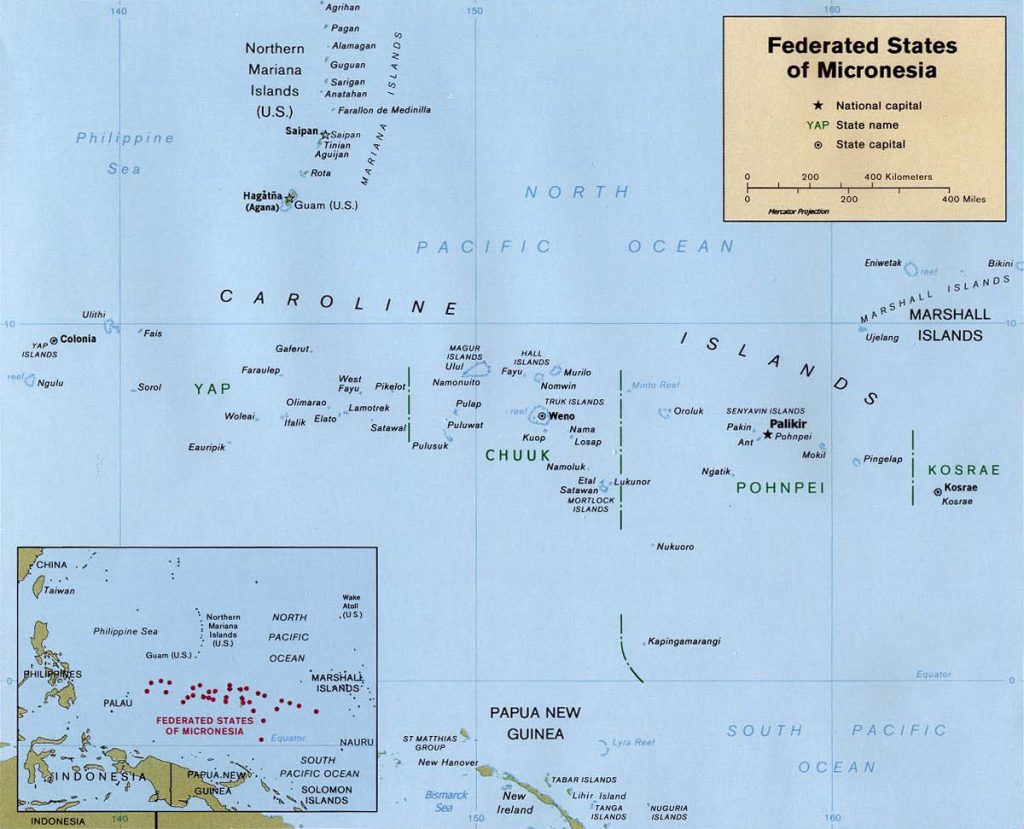
Federated States of Micronesia (PD0, CIA)
Located in Micronesia on the island of Pohnpei, the megalithic site of Pohnpaid is less than four miles from the UNESCO World Heritage Site of Nan Madol “Central” and less than two miles from the current official boundary of “Greater” Nan Madol, and as such, arguably merits inclusion in the Nan Madol complex.
The case for Pohnpaid
That Pohnpaid shares common elements with other major sacred sites or shamanic portals clearly qualifies it as one. Features of this upland rainforest archaeological site currently include: legendary status from deep antiquity; megaliths; stone circle(s); petroglyphs; goddess/fertility functions; soundscape; nearby running water; archaeo-astronomical mechanisms; interdimensional “doorway”; alignments to Nan Madol and other global sites; and location upon telluric and ancient precessional marker grids. It is anyone’s guess what else might be uncovered with a more thorough and technical investigation.
The antiquity of Pohnpaid is apparent, based on the lack of oral histories about the site’s function and the meaning of its petroglyphs. Oral history is sacrosanct for Pacific Islanders, and that no record exists of what transpired here speaks to its age — so old that local Pohnpeians have no legends of its use nor identity of its creators, with only two exceptions.
The first exception is a common storyline related to Pohnpaid’s creation that has survived yet includes no specifics or purpose for the site. Legends cite that two brothers (magicians/shamans) from a neighboring district stole a blanket or sheet (magic carpet?), which they then took to the petroglyph site and laid it down, creating the “writing” on the rocks. (As with most prehistory, there was no vocabulary to describe what might have been advanced technology or metaphysical abilities they possessed.) When finished, the brothers exited through a “doorway” in the middle of the basalt outcrop to worlds beyond, never to return. Unusual hollow sounds are emitted by pounding a rock on its surface that some claim signals the “doorway” location. All clearly indicating a portal to access interdimensional travel…more than a mere hint to Pohnpaid’s purpose.
Pohnpaid is undeniably a megalithic site as witnessed by its enormous stones (right side of core photo with adult for scale), most likely a stone circle(s), or at least a grouped configuration of megaliths at its core, all spread over a typically overgrown meadow. A huge natural basalt outcrop covered with petroglyphs is the other more well-known portion of the site adjacent to the incompletely documented meadow stones and petroglyphs. Both locations house anachronistic or sophisticated petroglyphs which speak for their importance and function. Future clearing and LiDAR imagery of the meadow will be necessary to reveal additional configurations and glyphs.
“Out of place” motifs
Expected would be the presence of hundreds of petroglyphs signifying Pohnpaid as a ceremonial center; the sophistication of its images is not. Likewise, as anticipated, the inherent problem with petroglyphs is both the difficulty in dating them and the expanse of time they cover before, during, or after the cataclysmic disaster at the end of the last Ice Age some 12,000 years ago. Again, Pohnpaid’s lack of oral traditions or interpretations of the patterns speaks to its antiquity.
The Pohnpaid site constitutes the largest assemblage of rock art known in Micronesia, if not the entire Pacific, with numerous motifs and configurations that are “out of time or place” in terms of their sophistication within conventional historical time frames of Oceania. From simple to complex, the range of petroglyph designs is documented only in The Petroglyphs of Mu: Pohnpei, Nan Madol and the Legacy of Mu.
One example of an “out of place” culturally or technically advanced motif at Pohnpaid is the winged disk configuration found upon one of the meadow boulders near the phallic megalith.
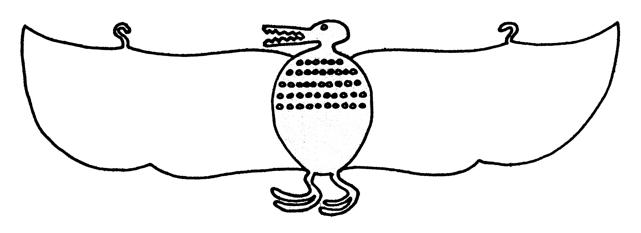
Wing disk motif of legendary bat, decoration above entry portals of bai traditional men’s houses, Belau, Micronesia, 1989 William Morgan
The surface of the phallic monolith is not the only appearance of a map or grid-like glyph at Pohnpaid. Another boulder’s incised pattern evokes a feeling of direction or location, perhaps beyond our planet and even the three customary dimensions.
Although it is not possible to confirm its original placement, this large boulder covered with an astonishingly complex petroglyph is found in what is tentatively identified as the outer Pohnpaid stone circle. Covering the visible side of it appears to be half of a “winged sun disk” motif consisting of a central double circle broken into twelve segments. This is similar to the classic houses of the zodiac, with one wing attached to the circular portion. Of note is that the zodiac is used not only by astrologers but also by astronomers to map the heavens. Protruding from one portion of the zodiac’s wheel is an outlined winged structure, bent near its center, with an infrastructure of shorter lines formed at ninety-degree angles to each other, such as the trusses of a bridge.
These ninety-degree angles in the wing may depict how ascended masters travel via their Merkaba, or “divine light vehicle.”
Similar in appearance to the winged disk motifs of antiquity, the Pohnpaid wing has an additional visual quality of a “you are here” map for interdimensional travel or space travel. The attachment area of the wing on the zodiac’s wheel could illustrate the entry point into our galaxy from points beyond, with the specific “route” of ninety-degree angles through interdimensional space-time showing the way to the home of the “mappers.” Interestingly, esoteric circles (with connections to Venus) refer to the use of the “ninety-degree phase shift” to pass into the “universe of timelessness,” or to put it another way, other dimensions, as the mechanism used by ancient elders who founded this Earth. When ready to surpass matter, energy, time, and space, they utilized this method to vacate this physical planet for nonphysical realms. This petroglyph could be a record of this process or route similar to that taken by the Els, Cyclopean Race (author: or Elohim) as described by George Williamson.
“Actually, the Els were not known by that name until they achieved this Theta condition. Before this they were known as the Cyclopean Race. It was their method of leaving physical existence and conditions that gave them the name of Els. Through the secret use of the Ninety-Degree Phase Shift they abandoned the Earth and the entire Galaxy and left it vacant for humanity. A ninety-degree angle forms the letter “L.” Therefore, when we call them Els we are referring to a symbol of their race and not really to a name.” (Williamson 1961)
Other geometric forms that appear to hang from the wing structure could be unrelated or belong to a different layer of glyphs. Accurate mapping of the stone surface is necessary before a coherent understanding or decoding of this intriguing pattern can be attempted. (Carole Nervig, The Petroglyphs of Mu: Pohnpei, Nan Madol and the Legacy of Mu, Bear & Company 2022)
When taken as a whole, Pohnpaid motifs make an undisputed case for cultural diffusion, yet not necessarily in the expected conventional pathways or timeframes that vestiges from a universal motherland would entail. What is conventional about Pohnpaid is the presence of the goddess culture.
What would an ancient sacred site be without the Goddess or fertility?
In addition to its creation by brothers and their blanket, the second exception of only two oral accounts surrounds a goddess and hints at Pohnpaid’s identity as a fertility site. Oral history relates that the enormous takai en pahsu is the vagina of a mythical woman “from the sky” who “broke into pieces” or was “eaten by a group of men” with only her vagina left at the site. (Pahsu in Pohnpeian literally means clam, but as slang means vagina; and takai means stone.) It is said that to this very day, merely touching this well-known megalith induces pregnancy. Two previously unknown takai en pahsu found on the site by the author reinforce Pohnpaid’s fertility theme. One is within the inner stone circle and twelve to fifteen feet in height found in 1992; the second, found in 2019, is a clam-shaped boulder with actual scallops engraved upon its side.
The male factor may well be represented by a gigantic phallus-shaped megalith. With no specific oral traditions associated with it, this label as “phallus” cannot be confirmed. Whether it relates to the legend of the magician Lapoange carving a nearby river channel with his penis is unclear. Its surface is smothered with countless sophisticated petroglyphs, thus adding more to its significance than just its size or shape.
Engraved upon the enormous basalt rock outcrop is another more literal representation of the goddess at Pohnpaid. Its similarity to a plethora of other archetypical mother goddess images cannot be ignored.
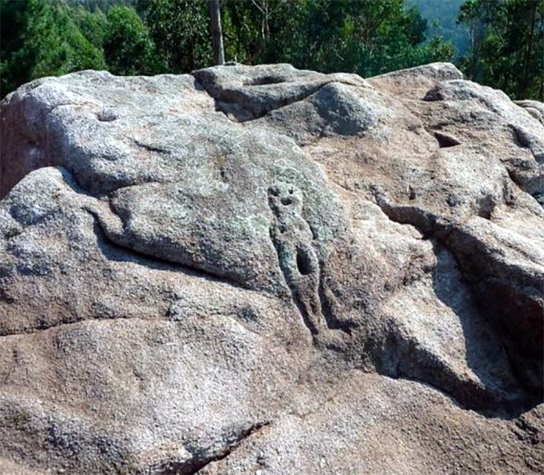
Goddess Sheela-na-gig-at-Moura-Pena-Furada, Coirós, Coruña (Elisardojm / CC BY-SA 3.0)
Presence of a mother goddess culture at Pohnpaid is further reinforced by a similar site on neighboring Kosrae Island. Menka was documented by archaeologist Felicia Beardsley and identified as the temple complex of the goddess Sinlaka.
Sinlaka, is a cognate of: Pohnpiean eel (aquatic serpent) goddess Ilake; Kosraean goddess Hiaka, who lived at the Leluh ruins; Hawaiian goddesses Laka and Hina; and Hindu goddess Laksmi. Of note is sea goddess Ilake Mwoluhsei who guarded Nan Mwoluhsei breakwater at Nan Madol adjacent to the legendary entry ‘gate’ of submerged Kahnihmueiso. Such cognate consistencies of “lak” serve to validate shared goddess identities as remnants of the universal mother culture of the Pacific, aka Mu or Lemuria.
Additional material evidence of Pohnpei’s goddess culture comes from a paper by Hilary Howes. Photographed in 1910 with Paul Hambruch, the site was labelled as the tomb of the Pohnpeian mother goddess Inaz/Inas. It is of note that if a burial was required, Inas would have been a physical entity or demigoddess rather than an ephemeral deity.

Lolong (burial) of Mother goddess Inas with Paul Hambruck seated on western wall, tol en loui (Hill of Loui), Nett, Pohnpei, 1910 production courtesy MARKK Museum am Rothenbaum, Hamburg.

Innana/Ishtar c1,800 bce, Mesopotamia (CC BY-SA 4.0)
More than compelling is the linguistic link between Pohnpei’s Inas/Inaz/Inaj/Inahs, and the at least 8,000-year-old Sumerian all-encompassing great mother goddess Innana/Inez/Ishtar often identified with serpents. Over millennia she evolved as goddess of the moon, fertility and procreation. Her names varied with cultures such as Astarte, Aprhrodite and Isis, as well as the universal personification of the morning and evening Stars or Venus.
Inanna is among the oldest deities whose names are recorded in ancient Sumer. She is listed among the earliest seven divine powers: Anu, Enlil, Enki, Ninhursag, Nanna, Utu, and Inanna.(Ancient History Encyclopedia)
On Pohnpei, Inas/Inaz/Inaj/Inahs was the living mother goddess, and also the ancestral matriarch of the Sounkawad clan, according to Pohnpei historian Bernart Luelen; F.W. Christian reports Ina Maram was the Pohnpeian moon goddess. On neighboring islands of Chuuk Lagoon, the goddess of happiness and love magic was named Inemes.
The cognates continue.
Native Hawaiian culture presents linguistic links not only with primordial matriarchal goddess Mo-o Inanea but with the word mu, (the mo-o were interchangeably referred to as the mu). Mo-o are typically female shapeshifters appearing as maidens, mermaids, lizards or water dragons.
Hina, the Austronesian word for “matriarch” and the name of several different Polynesian goddesses, often linked with eels and the moon, for example, Hawaiian moon goddess Hina. The Samoan legend of Sina, of the island of Savaii, and the freshwater eel are also well known throughout Polynesia, including Tonga, Fiji, and Aotearoa. In Rapa Nui mythology, Hina-Oio was the mother goddess of sea animals.
Continuing to Africa and South America, the links continue. Africa, Inna is Nigeria’s mother goddess of all spirits as well as harvest, protection, and justice. Ina is the dolphin goddess who lives in the waters of Brazil’s Amazon.
This goddess tradition serves as testimony to cultural diffusion from the earliest common origin — namely, matriarchal Mu.
But why is there scant reference to the goddesses of ancient Pohnpei? Perhaps the freshwater eel worshipping matriarchy was replaced by the more aggressive moray eel worshipping patriarchy when the Sahu Deleurs arrived at Nan Madol and dominated with their “new” religion of Nahnisohnsapw: the honored spirit of the land. (It is important to remember that even though the Sahu Deleurs’ new religion may have been patriarchal and more aggressive, it did consider the land sacrosanct, a pillar of Mu’s cosmology that persisted.)
Other explanations of the forgotten goddess involve conventional religion, which has a history of usurping pagan sites for their inherent power. In 500 CE, Pope Gregory set a historical precedent in suppressing ancient “pagan” goddesses and gods according to David Halpin. Spanish colonization brought Catholicism to Pohnpei in the 1800s, so what little was left of the goddess tradition, for the most part, vanished.
Elsewhere in the world, evidence of an enlightened, equalitarian mother culture, as originally identified by anthropologist Marija Gimbutas, survives as an intimate connection with both the natural world and the heavens. Pacific indigenous cultures clearly share this worldview.
Stargazing activities are often found in conjunction with fertility/goddess ritual sites, and once again, Pohnpaid is no exception.
Stars over Pohnpaid
Pacific seafarers are famous for their navigation skills from time primordial to the here and now. Knowledge of the stars is tantamount to traditional navigation, so it is no wonder that the ancient site of Pohnpaid displays astronomical motifs and mechanisms which add cultural astronomy to its functions.
One such archaeo-astronomical mechanism found in the Pohnpaid meadow would be a star reflector basin nestled within a large boulder covered with petroglyphs. That geometric, compass-like motifs actually touch the basin’s edge, provides evidence of its function of tracking star movements.
Observation is in order to determine if water is continually present in this shallow basin, as is shown in the photograph taken during a drought, which is not common for Pohnpei. Although rainfall is frequent, water caught in this boulder could evaporate quickly. It could be questioned whether or not a metaphysical factor keeps it full of water in the baking sun.
The petroglyphed basin stone probably used for stargazing is located in the outer stone circle. Its interpretation as an archaeo-astronomical device is based on its resemblance to similar megalithic water basin mechanisms found across a variety of cultures. Accurate prediction of celestial events was crucial to all ancient peoples, especially any culture of navigators, and was essential for establishing their religious and political authority.
The geometric style patterns that intersect the water depression on its surface indicate this particular water basin stone was used to track celestial movement. As the reflections of the night sky moved across the water’s surface, the etched markings indicate how a specific heavenly body changed its position. Without these glyphs it would be easier to assign a different function to the water in the basin. Perhaps it was used for purification or fertility rituals, for instance. Until scientific archaeo-astronomical calculations are measured, one can only guess as to what celestial alignments the stone articulated: solstices/equinoxes, solar/ lunar, stellar/constellational, or planetary. (Carole Nervig, 1992. The Petroglyphs of Mu: Pohnpei, Nan Madol and the Legacy of Mu, Bear & Company, Vermont.)
Awareness of celestial phenomena might also be demonstrated by a representation of the Pleiades, the constellation of the Seven Sisters. The images carved into this sizeable boulder appear to be stars or birds. The exact number of these stars cannot be confirmed specifically, but the author recalls there were seven as the Pleiades came to mind upon its discovery. Pohnpeian oral traditions state that Muakeriker or Mwakereker (Pleiades) is the greatest of all the stars or constellations, lending more credence to this identification.
The astronomical comprehension of the creators of Pohnpaid is apparent and is indicative of a sophisticated and technically advanced civilization.
Was Pohnpaid established concurrently with the city of Kahnihmueiso as its mountaintop observatory or temple, or later, as a memorial to what James Churchward claimed, one of the “Seven Cities of Mu” that were inundated by a cataclysm? This legendary sunken city predates Nan Madol for sure and predates or is at least contemporary with Pohnpaid.
But did their celestial knowledge end with the stars, or did they have a sense of their geodetic location as a sacred geometrical complex or node/navel/portal on a global system of sacred sites?
A Sense of Place
Megalithic libraries are not just images etched in stone. The stones, structures, sounds, and especially their configurations provide quite the curriculum. Even more pertinent is the rationale for site selection from a global perspective, as witnessed on Pohnpei.
Documented via oral history, the search for the perfect location for Nan Madol gives serious pause to the notion that its builders knew what they were looking for. After several failed attempts around the island, the brothers Olsipha and Olsopha climbed Takaieu Peak and, whether they knew it or not, looked across and down through the alignment from Pohnpaid to Kahihmueiso, culminating in the submerged “shining” city. Recognizing their target, they built Nan Madol next to it. However, smaller basalt structures already existed on this reef from the early first millennium CE, according to archaeologist Stephen Athens. The brothers added larger megalithic structures to the site from about 1,100 to 1,600 CE, well after the Pohnpaid site was established.

Line of sight from Pohnpaid cupules to Takaieu Peak to Pahndien Point (unlabeled) to Peiahni Rock (original surveying stone of Nan Madol) to Nakapw to Kahnihmueiso, 2020 Carole Nervig; base GoogleEarth
Was Nan Madol just a memorial to the lost lives and splendor of Kahihmueiso? Or did magician engineers (both its original creators, the Pali reef dwellers, and Olsipha and Olsopha who expanded it later) identify this location in a larger geodetic context within a worldwide system? Were memories and myths of Mu their guiding light to locate this portal, this lost city?
A possible scenario would be that earlier primordial ancient navigators, whether of the oceans, skies or dimensions, built Kahnihmueiso and its mountain temple Pohnpaid as the result of their esoteric awareness of this location as: an interdimensional portal; as a navel on a sacred site system grid; as a node on a great circle base and/or the planetary telluric energy grid and/or precessional marker grid; as a place to commune with the ancestors – or all of the above? This geodesic knowledge was embedded in the mother culture during the establishment of these initial grid(s) and their nodes in order to work in harmony with Mother Earth, helping to stabilize and amplify her energies. Those of Mu knew how to commune, to mold and merge with nature. Their understanding and practice of becoming one with Mother Nature — Mu’s ultimate legacy, would be wise for humanity to revisit and revitalize today — while there is still time.
That civilization may be much older and much more mysterious than we have been taught is becoming apparent with each passing day and decade. (Graham Hancock)
Bibliography
Athens, J. Stephen. 1984. “Surface Artefact Distributions at the Nan Madol Site: a Preliminary Assessment of Spatial Patterning.” New Zealand Journal of Archaeology. Vol. 6.
Beardsley, Felicia. 2014. Temple Architecture in The Sacred Site of Menka, Kosrae, Federated States of Micronesia, Studies in Global Archaeology no. 20.
Bernart, Luelen. 1977. The Book of Luelen. Honolulu: University Press of Hawai’i.
Christian, F. W. 1967. The Caroline Islands: Travel in the Sea of the Little Lands. London: Frank Cass & Co. Ltd.
Churchward, James. 1931. The Children of Mu. New York: Ives Washburn.
———. 1933. The Sacred Symbols of Mu. New York: Ives Washburn.
Edwards, Alexandra. 2017. “The Archeoastronomy of Kosrae and Pohnpei: An Explorers Club Flag #71 Expedition Report.” The Pacific Islands Research Institute (PIRI).
Edwards, Eric. 2013. “The Cult of the Mother Goddess.” Eric Edwards Collected Works.
Esteban, César. 2014. “Orientations and Astronomy of Prehistoric Monumental Tombs of Nan Madol.” Studies in Global Archaeology, no. 20.
Giacon, Adrienne. 2014. “Irihia the Homeland of the Maori?” The Weaver Prophecy theweaverprophecy.wordpress.com.
Gimbutas, Maria. 1991. The Civilization of the Goddess: The World of Old Europe. San Francisco: Harper.
Halpin, David. 2018. “Ancient Women Shaman of Ireland: Goddesses of Prophecy and Omens.” Ancient-origins.net
https://www.ancient-origins.net/myths-legends-europe/goddesses-prophecy-and-omens- 0011009
Geolines.ru. website. 2016. “Historical Geodesy.” https://geolines.ru/eng/publications/HISTORIC-GEODESY/
Hambruch, Paul. 1910. (NM Map 1910) 1932–1936. Ponape. In G. Thilenius, ed., Ergelmisse der Sudsee-Expedition 1908–1910. Hamburg, Germany: Friederichsen.
Hancock, Graham. 1998. Heaven’s Mirror: Quest for the Lost Civilization. New York: Three Rivers Press.
Hanlon, David. 1988. Upon a Stone Altar. Oahu: University of Hawaii Press, Pacific Islands Monograph Series, no. 5.
———. 2004. “Wone Sohte Lohdi: History and Place on Pohnpei.” In Pacific Places, Pacific Histories: Essays in Honor of Robert C. Kiste. Edited by Brij V. Lal, 195–215. Honolulu: University of Hawaii Press.
Howes, Hilary. 2022. “Shell trumpets sounding in the stone city: Paul Hambruch and Nan Madol.” Uncovering Pacific Pasts: Histories of Archaeology in Oceania. Canberra: Australia National University Press.
Mark, Joshua J. 2010. “Innana.” World History Encyclopedia. https://www.worldhistory.org/Inanna/
Morgan, William N. 1989. Prehistoric Architecture in Micronesia. Austin: University of Texas Press.
Nervig, Carole [Carole Jencks, pseud.]. 1970. Nan Madol. Trust Territory of the Pacific.
Nervig, Carole [Carole Jencks, pseud.]. 1989. Nan Madol. Pohnpei State Tourism.
Nervig, Carole [Caroline Hadley Nervig, pseud.]. 1996. “Journey to Mu.” In Earthwalking Sky Dancers: Women’s Pilgrimages to Sacred Places, edited by Leila Castle. Berkeley: Frog Ltd.
Nervig, Carole. 2001. “Nan Madol: Sacred City of the Pacific.” Hawai’i Committee for the Humanities Presentation.
Volcanoes National Park, funded by Hawaii Council for the Humanities.
Nervig, Carole. Forthcoming. Nan Madol Revealed.
Petersen, G. 1990. “Lost in the Weeds: Theme and Variations in Pohnpei Political Mythology.” Honolulu: University of Hawaii Press, Center for Pacific Studies, Occasional Paper series, no. 35.
Rainbird, Paul and Meredith Wilson. 1999. “Pohnpaid Petroglyphs, Pohnpei: A Report to the Federated States of Micronesia National Historic Preservation Office and the Pohnpei State Historic Preservation Office.” (June).
Sacred-texts.com. “The Dragon Ghost-Gods.” https://www.sacred-texts.com/pac/hlog/hlog28.htm
Saxe, Arthur. 1980. The Nan Madol Area of Ponape: Researches into Bounding and Stabilizing an Ancient Administrative Center. Trust Territory of the Pacific.
Scranton, Laird. 2018. Decoding Maori Cosmology: The Ancient Origins of New Zealand’s Indigenous Culture. Rochester, Vt.: Inner Traditions.
Varner, Gary R. 2012. Portals to Other Realms, Cup Marked Stones and Prehistoric Rock Carvings. Raleigh, N.C.: Lulu Press.
Williamson, George Hunt. 1961. Secret of The Andes. London: Neville Spearman.
World History Edu. 2021. “13 Most Famous Polynesian Gods and Goddesses.” worldhistoryedu.com. https://www.worldhistoryedu.com/most-famous-polynesian-gods-and-goddesses/








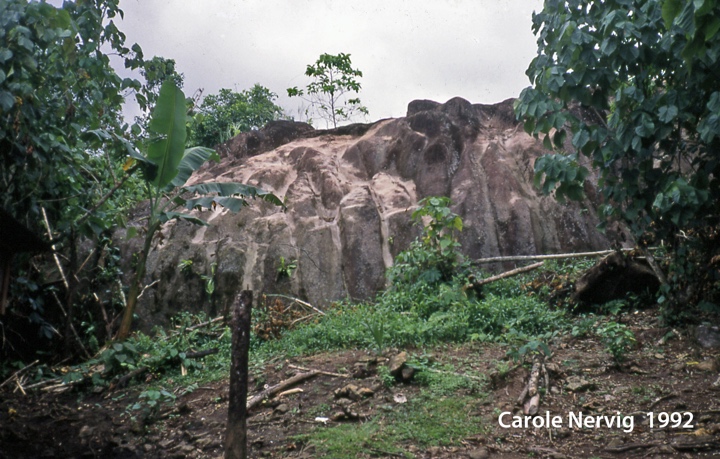
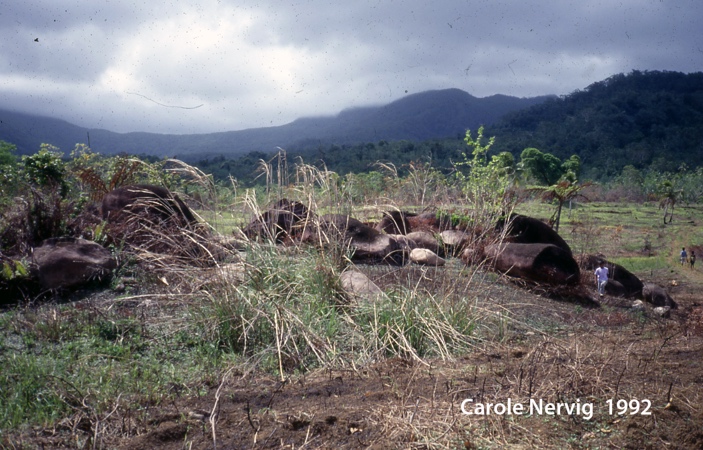

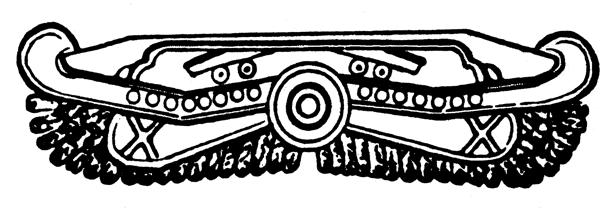
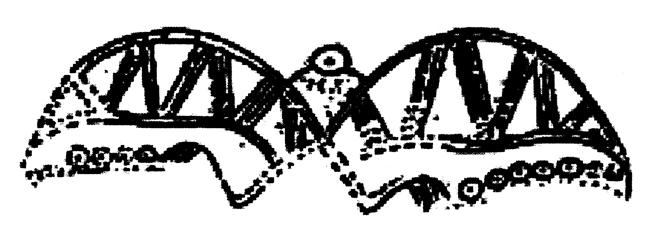




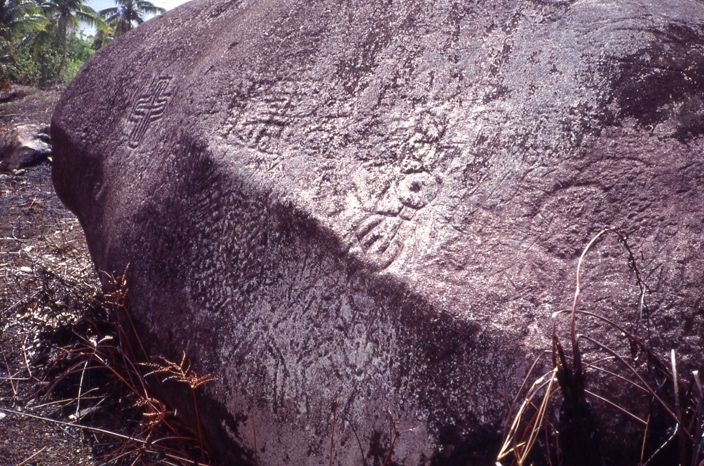
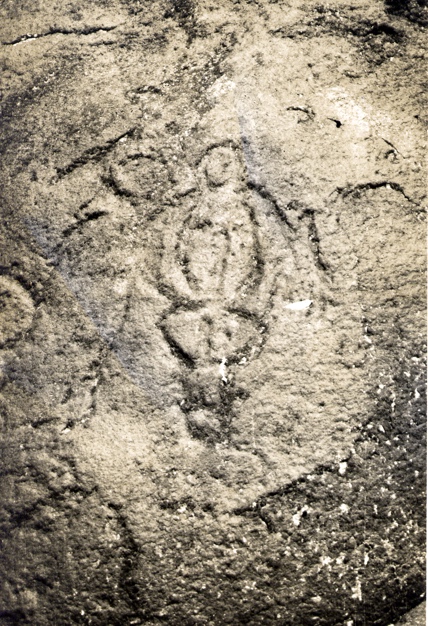
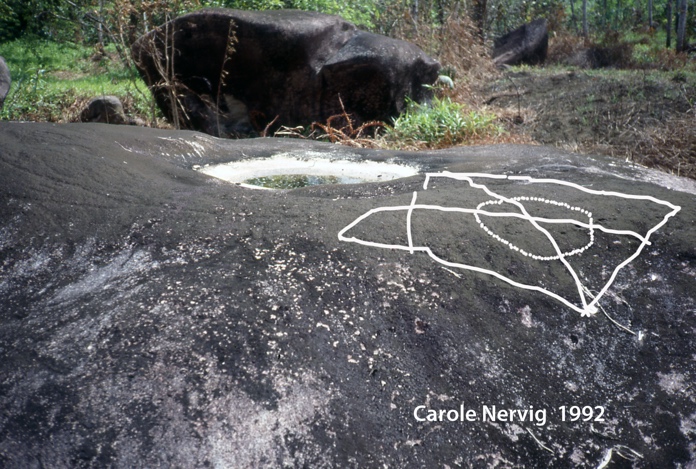

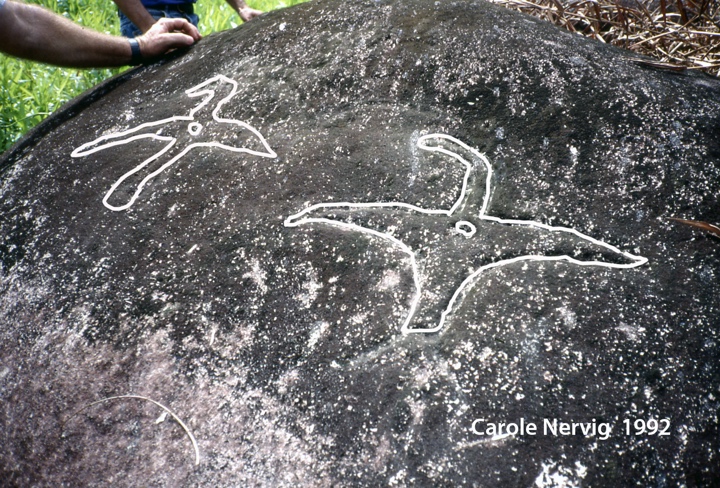
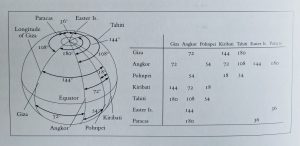
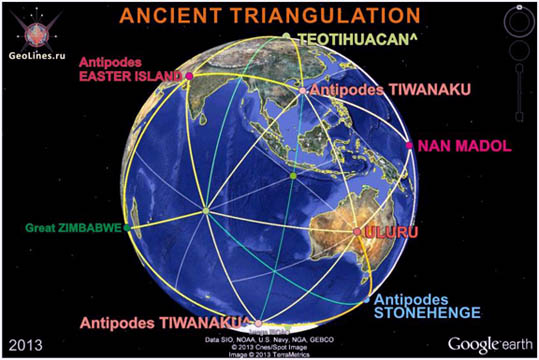
Wow. So much info here and so much to learn. Am looking forward to Carole’s second book about Nan Nadol. She has documented this area for current and future research.
I love petroglyphs, and in fact I was very interested to see that the picture you have displayed above titled “Petroglyphs phallic monolith, 1992 Carole Nervig” contains one shape I have seen before, in particular the outlined cross – but as well the other designs are quite reminiscent of the other petroglyphs in this same area, namely “Spirit Mountain” in Nevada, USA. I visited the site about a year ago, and spent a few days taking a large number of pictures as well as exploring the surrounding caves and mountains.
As you can see in this picture, the outlined shapes are quite prolific, including the exact kind of outlined cross: https://postimg.cc/Mvh0nNzD
I have also included a few other photos here with even more fascinating petroglyphs that you may find interesting:
https://postimg.cc/cKWQm3gt
https://postimg.cc/7503096y
https://postimg.cc/WDc7HKK3
And in fact, I have quite a large amount of other photos of this site – as it is certainly the most profuse collection of petroglyphs I have ever seen in one spot. The complexity and arrangement of the designs almost seems to indicate some sort of narrative structure as something sequential, or perhaps a catalog or some other kind of collection of images.
In the surrounding areas there are other less obvious but incredibly interesting finds, in particular a spot where someone has blown ochre over their hand prints in the typical “negative image” fashion.
If you enjoy petroglyphs I highly recommend visiting the site!
Thank you for sharing your photos. If I ever get back to Nevada, I must check out Spirit Mountain — the name say it all. The enveloped cross is highly distinctive and found in many locations in the Americas….and around the world. I assume there are always many layers of time represented at these petroglyph sites and sometimes different cultures. So difficult to date them, plus I am no archaeologist…
I see on the third photo a series of Xs. The same appears at Pohnpaid. Just did not have room to include in my book. According to some native American cultures, the Xs represent epochs or ‘changing of worlds’. I wonder how they would be interpreted at Spirit Mtn?
Thank you for your comments. Carole
I would like to talk with Gram Hancock as soon as possible. My beautiful lover and life companion have there is a carving inside the first on that resembles a Taurus symbol ( looks like a gold fish pointed towards the ground).
I have a video and a still pic of it if you would like to see? The second cave is much more interesting. Please have gram get in touch with me asap. I’m more than willing to take him to these places and also devote all of my time and abilities to help him with his work.
Thanks, Jason hartford
God Bless your research.